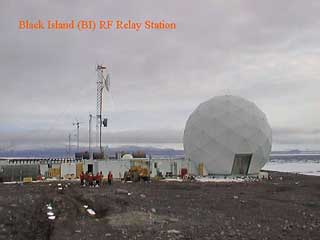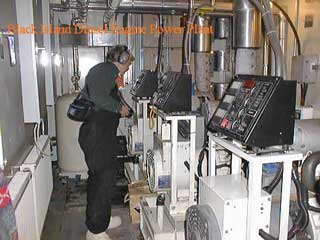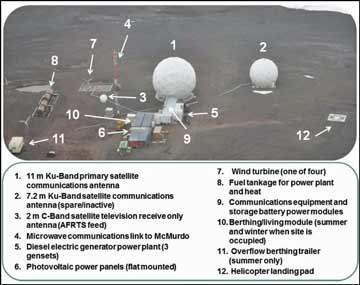Black Island
|
The site for what would eventually become McMurdo Station was selected at the beginning of the twentieth century by that famous British explorer Robert F. Scott. His site survey data came from earlier investigations conducted by James Clark Ross in 1841; Scott's criteria included: furthest southernmost access by sea to the Antarctic; an accessible anchorage with easy access to shore land; abundant wildlife as a food supply for men and animals; and potential access to a surface route to the South Pole. The name he gave to Winter Quarters Bay summarizes the reason for the site selection. Unfortunately for the present Antarctic program, Scott had no reason to consider the suitability of the site for access to geosynchronous communications satellites...which at the site latitude are only a few degrees above the horizon. Therefore, at this site they are obscured from sight by the most significant feature of Ross Island--Mt. Erebus. Accordingly, when the need to access such satellites arose in the 1980's, in January 1984 two INMARSAT Standard-A ship earth terminals were completed/commissioned by ITT ANS on Observation Hill near the old nuclear plant site, to access MARISAT F3 (location photo and information). This location proved unsuitable for the long term, as the satellite service was to be changed/relocated so that it would be inaccessible behind Mt. Erebus. A 1984 site survey was conducted by ITT/ANS engineer (and later coworker/friend) Bill Godley. After initial proposals to use Marble Point or the Daily Islands were determined to be unsuitable. the Black Island site was selected. Accordingly, in 1984-85 the INMARSAT terminals, an HF receive facility, Below, some documentation of the Black Island project: | |
 An aerial view of the Black Island facility in 1989-90. Photo by Garth Varcoe, Image No.: ANZSC0749.12, ©Antarctica New Zealand Pictorial Collection (link to original) | |
 The heart of the earth station in 1989-90. Photo by Garth Varcoe, Image No.: ANZSC0749.14, ©Antarctica New Zealand Pictorial Collection (link to original) |
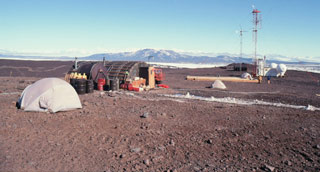 From another angle; here's the well-anchored Jamesway along with other short-term housing. 1989-90 photo by Garth Varcoe, Image No.: ANZSC0749.13, ©Antarctica New Zealand Pictorial Collection (link to original) |
|
Next...according to the 1 April 1991 NSF EAM Black Island Telecommunications Facility (BITF) Upgrade, additional HF antennas were erected in 1990-91 to improve flight following and field party communications. The next step, originally scheduled for the 1991-92 season per this EAM, involved the installation of what was originally proposed as a 6.1 meter transportable dish to provide four telephone circuits and a 56 kb/sec data channel. But first, there was some proof-of-concept testing in January 1992: | |
|
The precast concrete foundations for the antenna and radome (to anchor them from high winds) arrived on the ship in January 1992. The antenna materials were flown in at the beginning of the 1992-93 season. The first INTELSAT antenna actually turned out to be a NASA surplus/decommissioned 7.2 meter VertexRSI C-band antenna provided by Satellite Transmission and Reception Specialists (STARS), a company which had previously provided transportable earth stations for other venues including the 1984 Olympic Games in Los Angeles and the 1985 Live Aid concert in London and Philadelphia. STARS was acquired by IDB Communications in 1992; that venture would disappear after further mergers with MCI, Worldcom...etc.
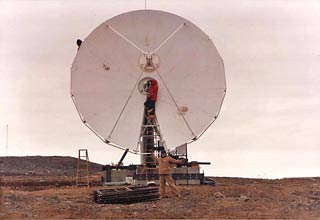 At right, after the dish was assembled, Todd Liccketto
is standing on the ladder installing the feed assembly.
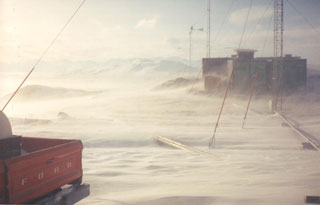 At right, a photo from Todd showing some of the typical lousy weather that the installation crew had to deal with.
At left above, an aerial photo of the earth station (NSF photo by Lynn Sumarski) from the 1993 Antarctic Journal review issue, which also indicated that the station was operating at 192 kb/sec. I'm unsure of the actual date of this photo...as one can see a radome as well as the 3 ORMAT generators. 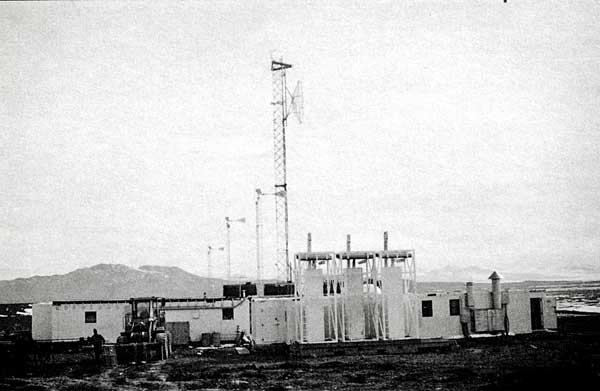 The new power plant module with 3 ORMAT generators. Additional wind turbines seen in the background. (NSF photo from the March 1994 Antarctic Journal). The antenna did not have a radome during that 1992-93 season. According to Todd Liccketto, they decommissioned (stowed) the antenna at the end of the summer season by lowering it to a "bird bath" position and removing all of the reflector panels to allow the winds to blow unimpeded through the structure. In 1993-94 the radome was fully erected and the antenna reflector panels were reinstalled, thus recommissioning the antenna for permanent use, as seen below. | |
 Delivering materials to the site by helicopter. |
|
|
Trivia...when Todd returned for his second season he privately brought a satellite video receiver...and was able to pick up AFRTS television signals...making Black Island a popular stop for helo pilots.
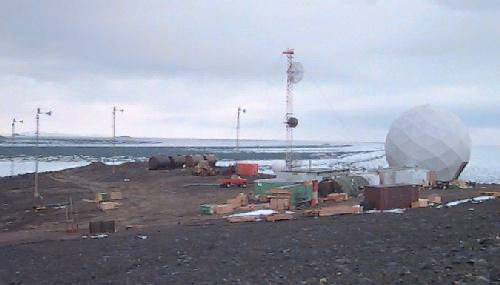 The above photo from Al Oxton is from his 1996 winter, but it is very similar to a smaller photo he emailed me in April 1995. Here's his description: looking roughly northwest from the slopes of Mt. Melania. At right of course is the new radome. Looking at about 8 o'clock from the radome is the equipment module for the communications hardware. East of that is the generator shack, and next to that is a Jamesway for additional temporary summer housing. Between the Jamesway and the microwave tower is the personnel module, with a galley-lounge at the north end, a bunkroom to sleep eight at the south end and PV arrays on the roof. In front of all that...one of several storage milvans. Next to the microwave tower is one of the original small white INMARSAT domes for backup satellite phone communications. In the background behind the red pickup is the old generator shack, the first of the (now four) wind turbine towers, and the four fuel tanks, two relocated and two more recently delivered. | |
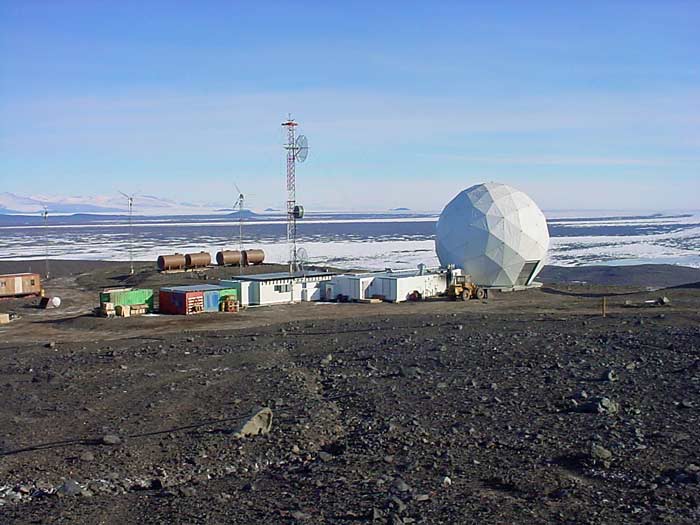 Compare Al's winter 1996 photo with this one from 10 years later, taken on 4 February 2005 by Cleve Cleavelin (who wintered at Pole in 1997). This is from the USAP Photo Library (link to original). The Jamesway is gone, but otherwise the place looks about the same. As it does 9 years later in the photo at the top of this page. Below, more photos of the site from this century: | |
 The living quarters in January 2007...a bit less bleak than that 1988 Jamesway...and there is indoor plumbing (!) Photo by Dominick Dirksen, from the USAP Photo Library (link to original) |
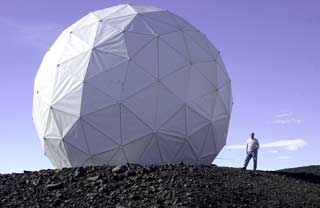 And a December 2001 closeup of the other side of the radome...along with Bill "Ol Bill" Robertson, who was part of the survey crew for the original project in 1990. Photo by Melanie Connor from the USAP Photo Library (link to original) |
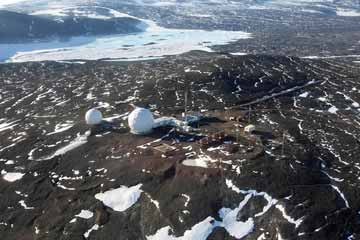 A larger aerial photo of the site as seen from a servicing helicopter approaching from McMurdo. These two NSF images are from the RFI attachment (see the communications history reference below). | |
|
Below...a summary of McMurdo satellite communications history, which mostly involves Black Island. 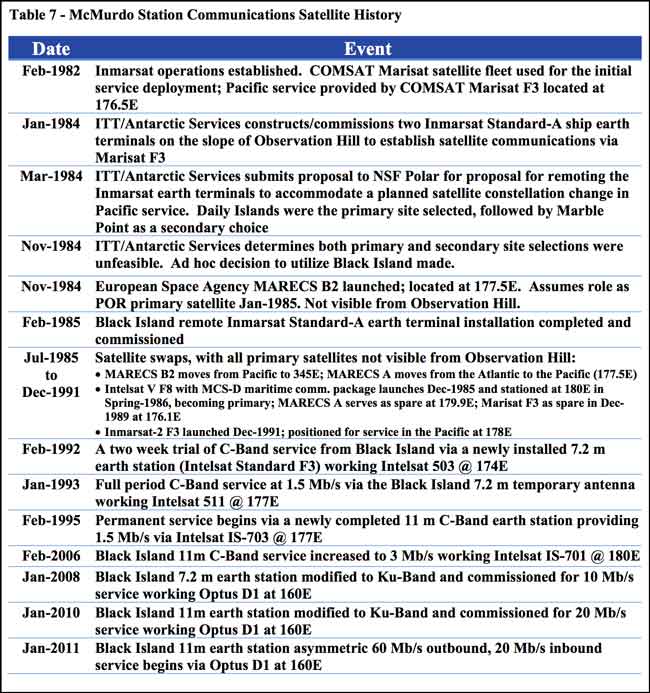 The above is from the NSF document "Attachment 1, United States Antarctic Program, McMurdo Station, Antarctica, Communications Needs Assessment", which was an attachment to this April 2015 RFI titled "Satellite Based Broadband Communications Services." One possible inaccuracy in the above document--the February 1992 "two week trial...via a...7.2 m earth station" may actually refer to the 6-foot portable antenna depicted above in tests conducted by Darwin Smith...after all, 7.2 meter portable antennas aren't that easy to obtain, ship, and install--and the VertexRSI/STARS antenna which actually was installed didn't show up until the 1992-93 season. This May 2010 Antarctic Sun article details the 2009-10 and pending 2010-11 upgrades to the Black Island facility mentioned in the above document. These led to northbound data rates of 60 megabits per second. When I did research for this page, I was very surprised that my usual excellent pre-internet information sources--NSF's Antarctic Journal and the New Zealand Antarctic journal Antarctic, contained...almost nothing. Other than the various photo and other sources mentioned above, the first main source for this page turned out to be a collection of my old email exchanges with longtime good friend Al Oxton dating from 1990, as well as some of the newsletters from his 1988 McMurdo winter which he later published online. He also wintered at McM in 1994, 1995, and 1996. A continuing theme of his emails was about how he seemed to be spending LOTS of time at this supposedly unmanned earth station. Later I obtained additional information from Dennis Tupick, who wintered at McMurdo in 1992 and was instrumental in the original earth station installation; Bob Jungk, another engineer intimately involved with the project; Todd Liccketto, who was the field engineer for the initial 1992-93 antenna installation (he returned for two further summers for proof-of-concept testing and full operational commissioning), and Tom Learned, who wintered in 1994 and worked on the foundation and radomes for the 11-meter antenna. Other references for this page include several NSF EAM's: from 1 April 1991--The Black Island Telecommunications Facility Upgrade--the original document, proposing an 11-meter antenna, two additional ORMAT generators, and two additional fuel tanks (as well as moving the original 2 tanks); from 31 December 1991--upgrade details--addressing the planned 6.1 meter antenna construction as well as plans for 2 temporary diesel generators during construction; from 13 January 1992--addressing a proposed greywater system with an evaporation pond; and from 22 January 1993-- addressing the installation of the 11-meter permanent INTELSAT earth station installed in 1994-95 as seen above. Also...the 1988 1:250,000 USGS map "Mount Discovery" which depicts Black Island available here (the map file is in c78192s1.zip), and this 2012 Quality Digest article which appears to describe a site inspection prior to the conversion of the two antennas to Ku-band service in 2008 and 2010. I should add that the current (June 2017) information I have is that the results of the recent referenced study indicate that the location for the new dish at McMurdo has been selected, either Observation Hill or Crater Hill/T-site. And I must sadly note that I first came across Garth Varcoe's 1989-90 photos of the original INMARSAT station while researching the October 1992 helicopter crash near Cape Royds, in which he and two others were killed. | |
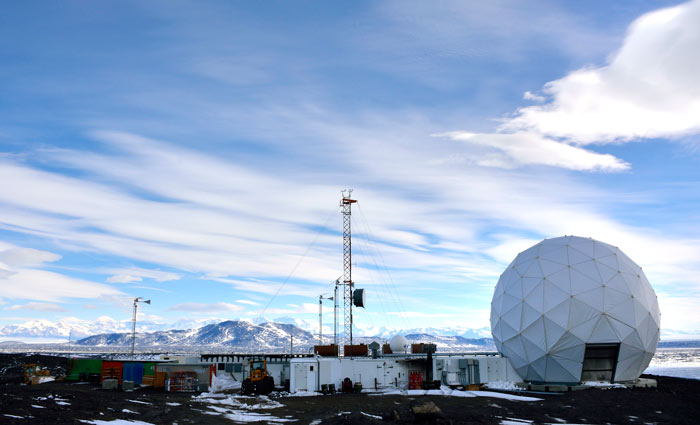
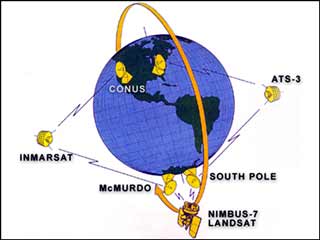

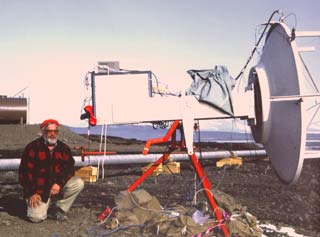
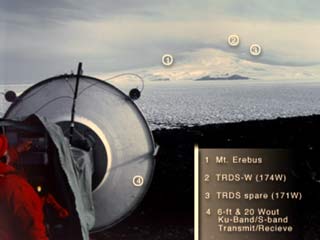
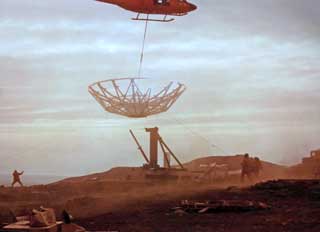
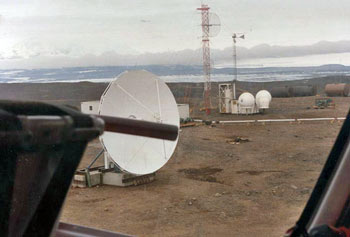
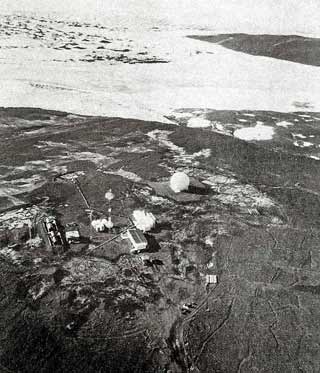
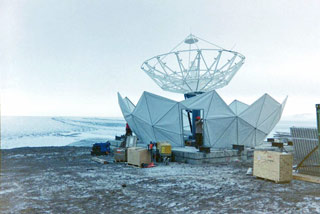
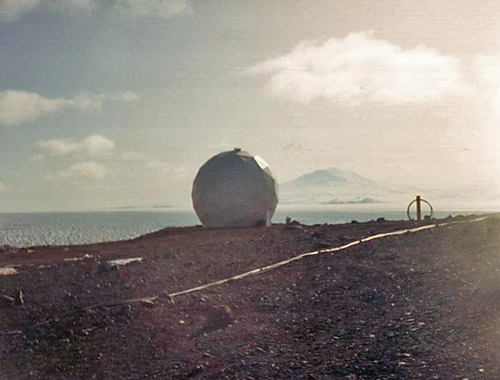
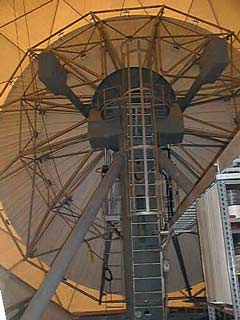
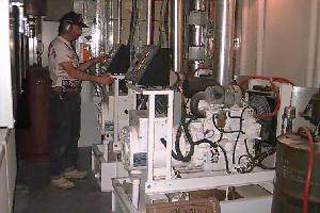 This photo is by NASA Mike Comberiate.
This photo is by NASA Mike Comberiate.